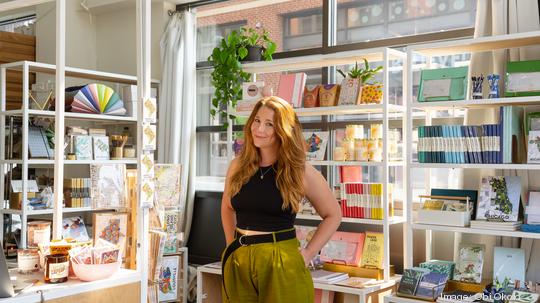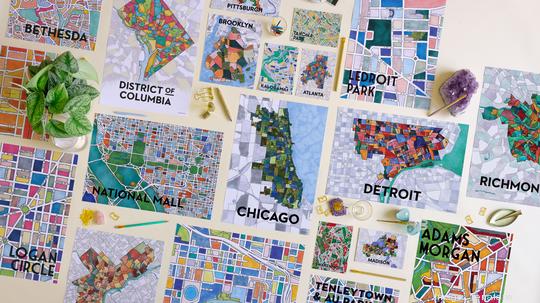
Torie Partridge, a former Army counterterrorism analyst and Arabic language analyst at BAE Systems, is founder of Brookland’s Terratorie, which produces and sells custom city maps, stationary and gift boxes. It was formerly known as Cherry Blossom Creative
At what point did you realize that your map art was a scalable business opportunity? When I launched the company in 2012, my focus was working on design services for clients. The first map I created was a mural for a local hardware store. The moment it went up people were begging me for prints that they could hang in their homes. The prints sold so well and I was completely caught off guard. I’d never even considered having a product as part of my design services business. I referred to the maps as the business’s “side hustle.” Five years into scaling a bona fide design agency, I took a hard look at the numbers and got honest about what parts of the business caused me stress. The maps were bringing in almost half the revenue, and unlike the constant churn and revision cycles of client work, they were bringing me creative joy and freedom in business.
How do you choose your next city to map? It’s a democratic process! Terratorie has a voting form on our website and we take requests online and in person. I’ve received more than 7,000 requests and counting at this time. I’ll occasionally push maps to the front of the line for representation purposes. I’m working to make sure that all areas of D.C. are represented. We also choose cities based on new retailer partnerships. Most recently we launched a Newark, New Jersey map that’s carried in the Newark Museum of Art.

What’s the most off the beaten path city or town you’ve been asked to map? Christchurch, New Zealand was recently requested at Adams Morgan Day. I told the gentleman, “Sounds like an excellent reason to take a business trip for purely ‘research purposes.’”
D.C. neighborhood borders are often not clearly defined. Have any proved particularly difficult to map? In all my years in the District, I’ve come to understand it’s a city pastime to argue about the official names of neighborhoods and where boundaries start and stop. It’s undoubtedly complex given the history of our city. Neighborhoods are shifting and new ones are invented by developers all the time. Rather than using official city planning data, I take a community-centered approach to the challenge. I speak directly to neighborhood residents, ask them about their neighborhood and what they feel are the true boundaries. I also work to create a maximalist version of each neighborhood map. While it’s impossible to make everyone happy, my hope is that everyone who feels connected to that neighborhood is included on the map.
Your career change was a 180. Was there an epiphany that led you to leave the DOD for design? The epiphany is a lesson that I've relearned many times since leaving the Middle East. Our lives are short and they are ours alone to design. Today, I choose to design a life of maximum happiness and fulfillment. My moment of clarity came during a year-long deployment in Baghdad. I was part of an Army program that offered community research and improved the cultural competency of soldiers. While my job had a shiny title, I was often isolated and miserable. The time alone proved a gift and allowed me to reflect outside of the constant career grind of D.C. I envisioned a life that was more peaceful, more creative and more connected to my loved ones and community. In my experience, it’s been a constant course-correction toward joy. I’m grateful for that moment of clarity and the conscious choice to abandon what I’ve always known for a life and business of my own creation.
Tell us a little about Brookland’s artist community. How did you land there? Terratorie moved to Brookland in the middle of 2020, after closing our Shaw shop for months due to the pandemic. Our Shaw lease was up at the same time that D.C. maker, Stitch & Rivet, was leaving her studio on the Brookland Arts Walk, so we swooped in! Terratorie is akin to a candy store for designers, creatives, small business owners and those looking for unique gifts. The space in Brookland is an absolute dream — 20-foot ceilings, windows on both sides filling the store with light, a big garage door which makes it feel like an indoor/outdoor space. But most importantly, we’re part of the community of makers. The Brookland Arts Walk is a beautiful pedestrian promenade with 27 different art studios and shops. We’ve got ceramicists, photographers, illustrators, fine artists, jewelers and community arts organizations, all working collectively to plan events and bring more art to NE D.C. Studios are all open on Saturdays along with a farmers market. I’d encourage anyone who hasn’t visited to make a day trip of it!
What was your first job? My first job out of college in 2007 was handling open source intelligence work for the Department of Homeland Security. I studied Arabic and the Middle East at McGill University, and my first job was to track insurgent and terrorist groups in online forums and on the dark web. Specifically, we were looking for users who were sharing bomb-making materials to create IEDs (Improvised Explosive Devices). Our team browsed and infiltrated forums. We then translated bomb-making manuals and propaganda to inform and alert the military and law-enforcement of new types of improvised weapons. Even through radical career changes, the skills I used then are the skills I use now: thoroughness, research, clear communication, teamwork and creative thinking. The current application of skills at Terratorie is simply much more rewarding and fun.
Have an idea or pitch that reflects some unusual business activity? Email mneibauer@bizjournals.com.